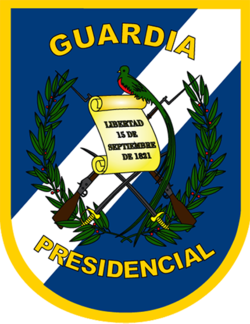
The President of Colombia is the head of state and head of government of the Republic of Colombia. The president heads the executive branch of the national government and is the commander-in-chief of the Military Forces of Colombia.
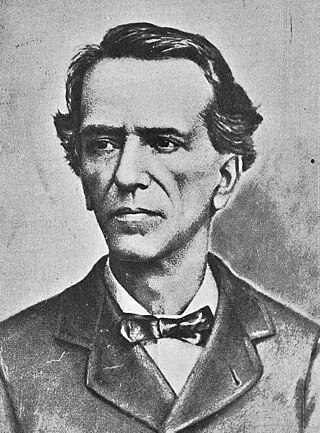
Miguel García Granados y Zavala was a Spanish-born Guatemalan politician and military general who served as President of Guatemala from 1871 to 1873.
The NicaraguanNational Guard was a militia and a gendarmerie created in 1925 during the occupation of Nicaragua by the United States. It became notorious for human rights abuses and corruption under the regime of the Somoza family (1936–1979). The National Guard was disbanded when the Sandinistas came to power in 1979.

The Government Palace, also known as the House of Pizarro, is the seat of the executive branch of the Peruvian government, and the official residence of the president of Peru. The palace is a stately government building, occupying the northern side of the Plaza Mayor in Peru's capital city, Lima. Set on the Rímac River, the palace occupies the site of a very large huaca that incorporated a shrine to Taulichusco, the last kuraka of Lima.
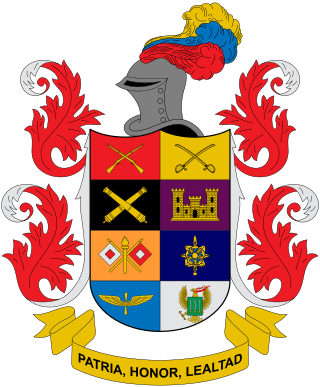
The National Army of Colombia is the land warfare service branch of the Military Forces of Colombia. With over 361,420 active personnel as of 2020, it is the largest and oldest service branch in Colombia, and is the second largest army in the Americas after the United States and before Brazil.

The Mexican Army is the combined land and air branch and is the largest part of the Mexican Armed Forces; it is also known as the National Defense Army.
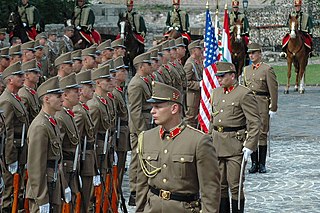
A guard of honour, honor guard or ceremonial guard, is a group of people, typically drawn from the military, appointed to perform ceremonial duties – for example, to receive or guard a head of state or other dignitaries, the fallen in war, or to attend at state ceremonials, especially funerals. In military weddings, especially those of commissioned officers, a guard, composed usually of service members of the same branch, form the sabre arch. In principle, any military unit could act as a guard of honour. In some countries, certain units are specially assigned to undertake guard of honour postings or other public duties. Republican guards, royal guards and foot guards frequently have ceremonial duties assigned to them.

The Bolivarian Army of Venezuela, is the land arm of the National Bolivarian Armed Forces of Venezuela. Also known as Bolivarian Army, its role is to be responsible for land-based operations against external or internal threats that may put the sovereignty of the nation at risk. The army is the second largest military branch of Venezuela after the Bolivarian Militia.
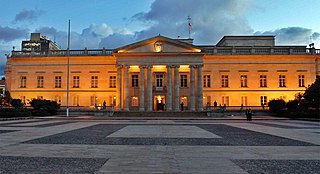
The Casa de Nariño, literally the House of Nariño, is the official residence and principal workplace of the President of Colombia. It houses the main office of the executive branch and is located in the capital city of Bogotá, Colombia. It was dedicated in 1908 after being constructed on the site of the house where Antonio Nariño was born. The design was made by architects Gastón Lelarge, a French-born former pupil of Charles Garnier, and Julián Lombana.
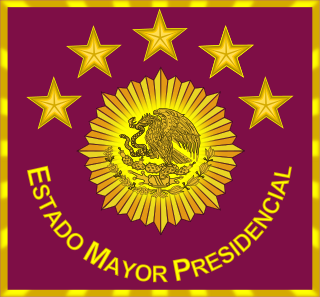
The Estado Mayor Presidencial — EMP was the institution charged with protecting and safeguarding the President of Mexico, the First Lady of Mexico and their immediate families. It is described in its regulations as a military technical body and an administrative unit of the Presidency of the Republic of Mexico in facilitating the President's fulfillment of his attributes and functions.

The Royal Guard is an independent regiment of the Spanish Armed Forces that is dedicated to the protection of the King of Spain and members of the Spanish royal family. It currently has a strength of 1,500 troops. While the Guard participates in parades and other ceremonial events, it is a fully functional combat unit. Its members are recruited from the ranks of all three branches of the Spanish Armed Forces and receive the same combat training as regular soldiers.

The Civil Guard was the main preventive police force of Peru until its dissolution in 1988. As a national gendarmerie force, it was responsible for civil policing under the authority of the Ministry of the Interior, while investigative work was carried out by the Peruvian Investigative Police. It was also supported at times by the Republican Guard. During its dissolution process, it became known as the General Police until its formal integration into the National Police of Peru in 1991. The corps is colloquially known as the benemérita (reputable).
Law enforcement in Peru is carried out by two organizations under the direction of the Ministry of the Interior:
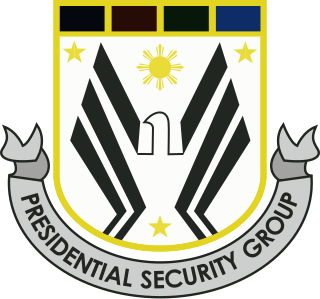
The Presidential Security Command, (PSC) formerly known as Presidential Security Group (PSG), is a Philippine close protection agency. It is the primary agency concerned with providing close-in security and escort to the President of the Philippines, their immediate families, former presidents of the Philippines as well as visiting heads of state.

The Presidential Guard Battalion, also known as Duke of Caxias Battalion, or by its historical designation Emperor's Battalion, is a unit of the Brazilian Army and honour guard to the President of Brazil. Two other units, the 1st Guards Cavalry Regiment and the Cayenne Battery, are also part of the presidential honour guard unit. It is currently a part of the Planalto Military Command.

The Republican Guard of Peru was a branch of the Peruvian National Gendarmerie responsible for providing security to the headquarters of public institutions and penitentiary establishments, as well as border control.

The "Mariscal Domingo Nieto" Cavalry Regiment Escort is the Household Cavalry and Dragoon Guards regiment of the Peruvian Army since 1904, having been inactive from 1987 to 2012.
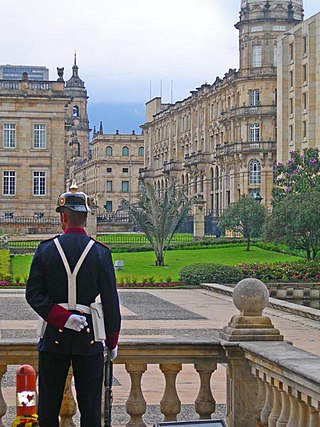
The 37th Infantry Battalion "Guardia Presidencial" is the President of Colombia's honor guard service unit under the National Army of Colombia. It is composed of five companies, a historical company and one artillery battery plus a military band, a fanfare trumpet section and a Corps of Drums. It is stationed at the Casa de Nariño in Bogotá and carries the traditions of Simon Bolivar's infantry guards company raised in the midst of the Spanish American wars of independence in 1815.

The Presidential Escort Group "Granaderos de Tarqui" is the President of Ecuador's honour guard service regiment, which protects the Carondelet Palace in Quito. Granaderos de Tarqui, means Tarqui Grenadiers in Spanish.

The Presidential Honor Guard is the military brigade responsible for the immediate security of the president of Venezuela. The current head of the Presidential Honor Guard is Iván Hernández Dala.
